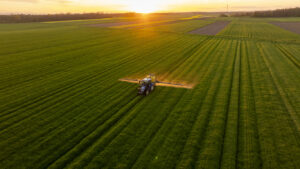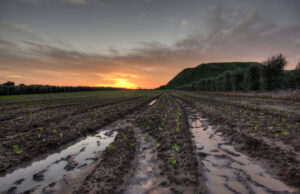Exclusive CropX Guidance: Helping Central U.S. corn and soybean farmers make every drop count
Mid-season marks a critical point in the growing cycle, when your crop is either set up for success or begins to fall short of its potential. Whether you’re focusing on mid-season irrigation for corn at tasseling or soybeans approaching pod set, making the right water decisions now can significantly impact yield, input efficiency, and soil health.
At CropX, we’ve compiled insights from our agronomy team and sensor data analytics to guide your mid-season irrigation strategy, helping you protect your crop while using water wisely.
- Know Your Root Zone: Where Crops Are Really Drinking
Not all soil moisture is equally useful. To irrigate effectively, you need to know not just how much water is in the soil, but where your plants are actually using it.
Your root zone is the portion of the soil profile where active water uptake occurs. This varies by crop, growth stage, and soil type. Mid-season is when crops typically expand their rooting depth, especially under mild stress. By tracking root activity through moisture graphs, you can:
- Identify active root depths: Water use patterns help you determine which sensors are showing the most depletion. These are likely the depths where roots are most active.
- Avoid overwatering deep layers: If roots are mainly active in the top 12–18 inches, irrigating to refill a 36-inch profile could waste water and risk leaching.
Tip: Use stacked soil moisture graphs to clearly visualize how deep root activity extends and adjust your irrigation targets accordingly.
- Set (and Re-Set) Refill Points Based on Crop Behavior
Your refill point, the soil moisture level at which you trigger irrigation, shouldn’t be static. As the season progresses, rooting depth changes, and water availability fluctuates, your irrigation thresholds should adapt.
Here’s how to think about it:
- Early season: Be conservative, roots are shallow, and there’s less water in the soil profile.
- Mid-season: You can often delay irrigation a bit longer between events to encourage deeper rooting, as long as plants aren’t stressed.
- Late season: Consider lowering your refill point gradually to stretch limited water or align with crop maturity.
Watch for signs like:
- Flattening slopes in top sensors (indicating dry soil nearing wilting point).
- Increased use at deeper sensors (suggesting roots are reaching down).
Tip: If your crop consistently uses 1″ of water between irrigations, set your refill point at least 1–1.5″ below your full line to ensure capacity for rainfall and avoid saturation.
- Managing Allocations or Limited Water
In many regions, water is allocated or restricted, and every drop matters.
When supply is limited:
- Stretch irrigation intervals by an extra 1–2 days if crop health allows.
- Accept a gradual downward trend in soil moisture but monitor closely to prevent stress during critical stages.
- Prioritize timing: For corn, tasseling is the most sensitive stage. For soybeans, pod set is key. Make sure moisture is available during these windows.
Tip: Strategically managing mild stress can extend available water without sacrificing yield, especially if rainfall helps you recover.
- The Approach to Final Irrigation in the Midwest US
As we approach the final stages of the growing season, many growers in the Midwest will begin considering their last irrigation. While this season has been abnormally wet, if rainfall begins to taper off in the next couple of weeks, many will be wondering if they have enough moisture to finish the crop or if an additional irrigation will be needed. It’s essential to closely monitor soil moisture levels and crop stress, particularly as we near tasseling for corn or pod set for soybeans.
Tip: If rains stop, consider making one final irrigation to ensure crops finish strong, but avoid over-irrigating to conserve water for the remainder of the season.
- Don’t Panic Over “Missing” Irrigations in Your Data
Sometimes growers worry when their CropX sensor doesn’t show an obvious spike in soil moisture after irrigation. A few common causes:
- Shallow irrigation that doesn’t reach the sensor depth (e.g., 0.6″ water might not infiltrate 8″ down in heavy soils).
- Sensor placement in non-representative areas (compacted zones, field edges).
- Sensor calibration or soil contact issues after installation.
What matters most isn’t whether you see a spike, it’s the trend:
- Flat = you’re keeping up.
- Downward = consider irrigating.
- Upward = hold off and let roots access stored moisture.
Tip: Use trend lines across weeks, not just daily readings, to make informed decisions.
- Every Field is Different – Even Across the Road
A final reminder: Proximity doesn’t equal uniformity. One field might be trending downward while a neighboring one maintains moisture, thanks to slight differences in soil, slope, or irrigation performance.
Relying on real-time, in-field data, not assumptions, is the best way to stay efficient and protect your yields.
Make This Mid-Season Count
Mid-season is when small decisions can make a big difference. Understanding your crop’s water needs, how deeply it’s rooting, and how your soil holds moisture puts you in a better position to finish the season strong.
Whether you’re dealing with limited water, unpredictable rainfall, or just trying to fine-tune your timing, the key is to stay responsive.
Our recommendations are shaped by real-time soil sensor data, field trials, and on-the-ground agronomy support. That’s why they help you make confident mid-season decisions, no matter the weather.
Want to dive deeper? Watch our free webinar on mid-season irrigation strategies to learn how to optimize root zone use, fine-tune refill points, and boost yields. Watch the webinar here ›




